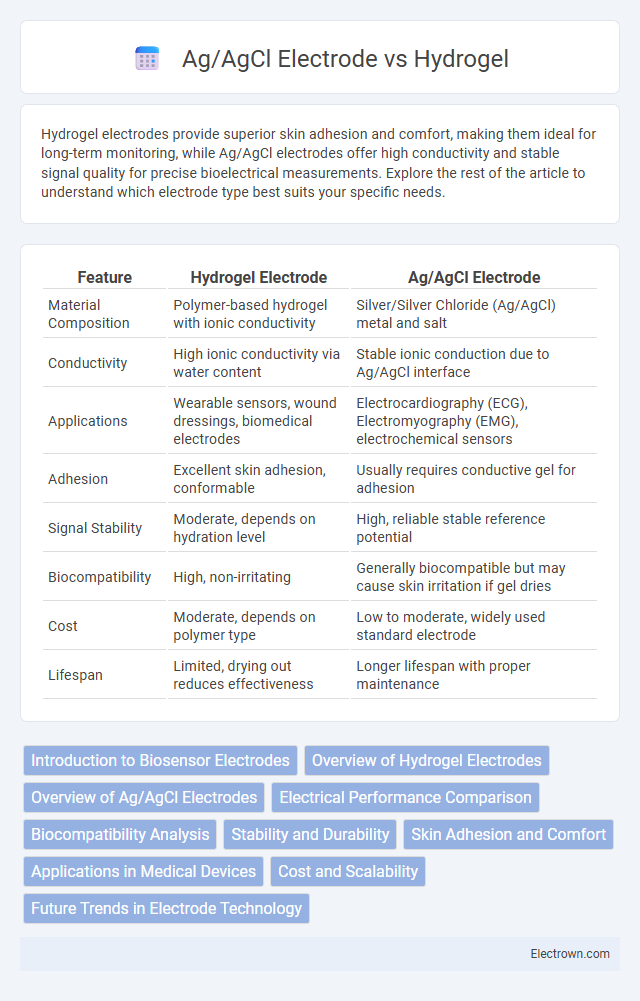Hydrogel electrodes provide superior skin adhesion and comfort, making them ideal for long-term monitoring, while Ag/AgCl electrodes offer high conductivity and stable signal quality for precise bioelectrical measurements. Explore the rest of the article to understand which electrode type best suits your specific needs.
Table of Comparison
| Feature | Hydrogel Electrode | Ag/AgCl Electrode |
|---|---|---|
| Material Composition | Polymer-based hydrogel with ionic conductivity | Silver/Silver Chloride (Ag/AgCl) metal and salt |
| Conductivity | High ionic conductivity via water content | Stable ionic conduction due to Ag/AgCl interface |
| Applications | Wearable sensors, wound dressings, biomedical electrodes | Electrocardiography (ECG), Electromyography (EMG), electrochemical sensors |
| Adhesion | Excellent skin adhesion, conformable | Usually requires conductive gel for adhesion |
| Signal Stability | Moderate, depends on hydration level | High, reliable stable reference potential |
| Biocompatibility | High, non-irritating | Generally biocompatible but may cause skin irritation if gel dries |
| Cost | Moderate, depends on polymer type | Low to moderate, widely used standard electrode |
| Lifespan | Limited, drying out reduces effectiveness | Longer lifespan with proper maintenance |
Introduction to Biosensor Electrodes
Biosensor electrodes play a crucial role in converting biological signals into measurable electrical signals, with Hydrogel and Ag/AgCl electrodes being prominent types. Hydrogel electrodes offer superior biocompatibility and enhanced ion conductivity, making them ideal for long-term skin contact and minimizing irritation during continuous monitoring. Ag/AgCl electrodes provide stable and reliable reference potentials, widely used in electrochemical sensing due to their low noise and consistent signal performance.
Overview of Hydrogel Electrodes
Hydrogel electrodes consist of a conductive polymer matrix embedded with water-retentive polymers, enabling superior skin conformity and moisture retention for enhanced signal acquisition in biopotential measurements. These electrodes offer low skin impedance and high biocompatibility, making them suitable for long-term monitoring applications such as ECG, EEG, and EMG. Compared to Ag/AgCl electrodes, hydrogel electrodes reduce skin irritation and provide improved comfort without compromising signal quality.
Overview of Ag/AgCl Electrodes
Ag/AgCl electrodes consist of a silver wire coated with silver chloride, widely used as reference electrodes in electrochemical measurements due to their stable and well-defined potential. Their performance relies on a chloride-containing electrolyte, making them suitable for aqueous environments where consistent reference potential is crucial. Hydrogel electrodes often incorporate Ag/AgCl sensing elements to enhance skin contact and reduce impedance in biopotential monitoring applications.
Electrical Performance Comparison
Hydrogel electrodes offer lower skin-electrode impedance and improved signal stability compared to Ag/AgCl electrodes, enhancing electrical performance in biopotential monitoring. Ag/AgCl electrodes provide high conductivity and reliable signal quality but can suffer from drying out and increased noise over time. Your choice impacts signal fidelity and long-term measurement accuracy in electrophysiological applications.
Biocompatibility Analysis
Hydrogel electrodes exhibit superior biocompatibility due to their high water content and soft, flexible structure, which minimizes skin irritation and enhances comfort during prolonged use. Ag/AgCl electrodes, while effective in signal conduction, may cause skin irritation or allergic reactions over extended periods due to their rigid material composition. Biocompatibility analysis consistently shows hydrogel electrodes as preferable for sensitive skin applications and long-term monitoring in medical and wearable technologies.
Stability and Durability
Hydrogel electrodes provide enhanced skin conformity and comfort but may experience reduced long-term stability due to dehydration and wear over extended use. Ag/AgCl electrodes offer superior durability and consistent electrical performance, maintaining stable impedance levels during prolonged monitoring sessions. Your choice should balance the need for comfort with the requirement for reliable and long-lasting signal acquisition in clinical or research applications.
Skin Adhesion and Comfort
Hydrogel electrodes offer superior skin adhesion due to their soft, flexible matrix that conforms closely to skin contours, reducing discomfort during long-term monitoring. Ag/AgCl electrodes rely on adhesive gels that can cause irritation or allergic reactions, compromising comfort over extended use. Your choice of electrode material significantly impacts wearability and user experience, with hydrogel providing a gentler and more secure attachment.
Applications in Medical Devices
Hydrogel electrodes provide superior skin adhesion and enhanced comfort, making them ideal for long-term monitoring in medical devices like ECGs and wound care sensors. Ag/AgCl electrodes offer high conductivity and stable signal quality, commonly used in diagnostic equipment such as EEG and EMG for accurate bioelectrical recordings. Your choice between hydrogel and Ag/AgCl electrodes should consider factors like wear duration, signal precision, and skin sensitivity to optimize device performance.
Cost and Scalability
Hydrogel electrodes typically offer lower material costs and simpler manufacturing processes compared to Ag/AgCl electrodes, making them highly scalable for mass production in wearable and disposable medical devices. Ag/AgCl electrodes require silver-based compounds, which increase material expenses and demand more complex fabrication techniques, limiting large-scale cost efficiency. The scalability of hydrogel electrodes benefits from their compatibility with roll-to-roll printing and flexible substrate integration, crucial for expanding output while maintaining affordability.
Future Trends in Electrode Technology
Future trends in electrode technology emphasize the integration of hydrogel materials with Ag/AgCl electrodes to enhance biocompatibility and signal stability in wearable and implantable sensors. Innovations in hydrogel formulations aim to improve ionic conductivity and mechanical flexibility, addressing limitations of traditional Ag/AgCl electrodes in long-term monitoring applications. Advances in nanomaterial composites and microfabrication techniques are expected to drive the development of hybrid electrodes that offer superior electrochemical performance for medical diagnostics and neuroengineering.
Hydrogel vs Ag/AgCl Electrode Infographic

 electrown.com
electrown.com